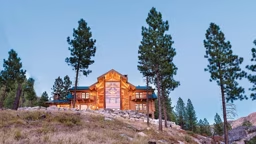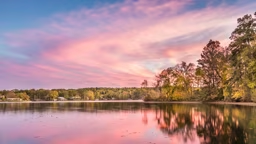
When you're selecting land for your log home, remember the old real estate adage — location, location, location. Future homeowners quickly become smitten with what seems to be the ideal spot, whether it's a mountainside plot deep in the woods or a lakefront lot near a lucky fishing hole. But there are a few rules to finding the right site that you should follow before saying "I do."
First Things First
The first step is to make sure that the land is, in fact, buildable. "Most soil passes the test," says Lynn Gastineau, president of Gastineau Log Homes. "But you need to make sure that nothing about the land prevents you from getting a building permit." If you're buying from a real estate company, your agent should help you with the legwork. If you're buying from an individual, you'll have to do the research, yourself. That includes examining local building codes (such as road frontage requirements and height limitations) to make sure that the land is zoned for private homes — and that it's considered big enough to build on.
Working With the Land
If you have a specific vision for your log home, remember that the land you buy may impact your design choices. "On some tracts of land, property-line setbacks will influence the size home you can build — particularly on waterfront properties, which tend to be smaller," explains Brian Breit, national sales manager for Wilderness Log Homes. "To prevent problems, take your builder with you to look at the land," suggests J.W. Stephens, a designer-developer from JWS Inc. in Blue Ridge, Georgia. "A builder can help determine if the property will accommodate your idea of the perfect log home."
High Expectations
Mountain property can be the most challenging and expensive landscape to build on, says Gastineau. Difficult mountain roads may require staged deliveries to the job site. And a steep slope can increase the cost of porches and decks. "If you're on a tight budget, you might want to go with a creek or valley view instead," says Gastineau. She adds that the slope of the ground can also limit your home's width. "Building a house on a concrete slab is impractical in the mountains; building a basement is more cost-effective."
A River Runs Through It
Properties with creeks and gullies have their own challenges — especially if flooding is a risk. If this is the case, make sure you have enough land to build your home at a safe distance from the water. This is also a consideration when building on clay. "The area around the foundation should be back-filled with a stone product instead of clay to allow for drainage," says Breit, who adds that drainage needs can also affect the look of your log home. "Gutters and downspouts can detract from a home's rustic character, so I often suggest using larger overhangs or a steeper roof as an alternative — especially in snow country."
Special Delivery
Considering location is essential when selecting your log home package. "In general, you can run into location-related issues if you take a plan straight out of a plan book," suggests Nunn. "That's what we call the tail wagging the dog." Instead, he recommends finding property that you love and designing a log home exclusively for that site. "Try to envision how your home will fit in with its surroundings. For example, instead of building right on top of a mountain where houses tend to look out of place, site your home off the ridge a bit to blend it into the landscape." And, of course, don't forget the view, urges Gastineau. "Aim for a design that takes advantage of the scenery from as many living areas as possible."
 When you're selecting land for your log home, remember the old real estate adage — location, location, location. Future homeowners quickly become smitten with what seems to be the ideal spot, whether it's a mountainside plot deep in the woods or a lakefront lot near a lucky fishing hole. But there are a few rules to finding the right site that you should follow before saying "I do."
When you're selecting land for your log home, remember the old real estate adage — location, location, location. Future homeowners quickly become smitten with what seems to be the ideal spot, whether it's a mountainside plot deep in the woods or a lakefront lot near a lucky fishing hole. But there are a few rules to finding the right site that you should follow before saying "I do."
 When you're selecting land for your log home, remember the old real estate adage — location, location, location. Future homeowners quickly become smitten with what seems to be the ideal spot, whether it's a mountainside plot deep in the woods or a lakefront lot near a lucky fishing hole. But there are a few rules to finding the right site that you should follow before saying "I do."
When you're selecting land for your log home, remember the old real estate adage — location, location, location. Future homeowners quickly become smitten with what seems to be the ideal spot, whether it's a mountainside plot deep in the woods or a lakefront lot near a lucky fishing hole. But there are a few rules to finding the right site that you should follow before saying "I do."











